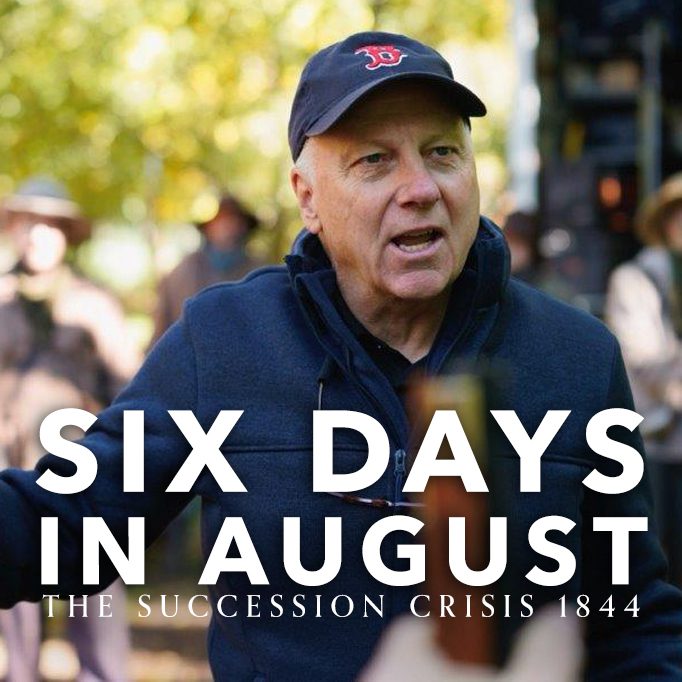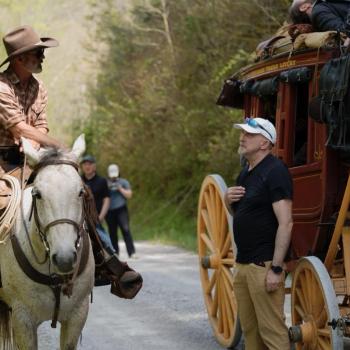
My wife and I took our core film production and film distribution and film bookkeeping group out to dinner last night, both for Christmas and to celebrate the near-conclusion of the dramatic-film portion of our overall Six Days in August project. (One more contract is awaiting completion. The others have been signed. And then it’s onward and upward.)
Curiously, by the way, the film continues to be shown in a theater in Kaysville, Utah. So, if you’re anywhere near Kaysville and you haven’t yet seen it, there is still time for your repentance in sackcloth and ashes — although, given the weather, you should probably dress more warmly for the actual theater itself. And, if you want to see the movie again on (what I assume is) a big screen, you still have perhaps a final opportunity to do so, evidently into the next week or so.
And I’m told that DVDs (and possibly Blu-rays) of Six Days in August will be available next week. (Unless something goes awry, streaming should follow. But I don’t yet know exactly when.) I’ll try to let you know, if I can — I’ll be on the road next week — when those DVDs and Blu-rays are actually on the shelves at Deseret Book. They would make excellent Christmas gifts — even stocking stuffers — for family members, friends, neighbors, and the people to whom you minister, as well as for your fifty thousand employees at Acme Megahuge Company, for those buying combo meals at your fast-food stand, and for random passing strangers on the street. When Jehovah’s Witnesses knock at your door, have a copy of Six Days in August waiting for them. (And don’t forget Witnesses. They’ll love it.)
Six Days in August did not, I readily admit, do anywhere near as well at the box office as we had hoped and expected it to do. We’re still trying to understand why that was so. And we’re not the only people who are wondering about where theatrical movie-going stands right now. Here’s a quintet of relevant links:
- Forbes: “Is The Death Of Movie Theaters Upon Us?”
- Wall Street Journal: “How Going to the Movies Is Changing, in Charts: Hollywood’s new normal involves fewer wide releases, more big screens and novelty popcorn” (“America’s box office is fighting for a comeback. A Hollywood ending still seems far off.”)
- Wolf Street: “US Movie Ticket Sales -46% in 2023 from 21 Years Ago: AMC and the Movie Theater Meltdown: Americans have changed how they watch movies. They watch more than ever, but at home.”
- mxdwn.com: “Why Has Movie Theater Attendance Declined?”
- Advan: “A Look into Movie Theater Attendance Post-Pandemic”
Over at the Peterson Obsession Board, where the large majority of the inhabitants have almost certainly not seen the film — it saves time, right? one can begin immediately to mock and express contempt — they are confident that Six Days in August didn’t do very well at the box office because it was an amateurish piece of boring cinematic garbage, mere simple-minded propaganda. They know that those who failed to see it were sending an explicit message of disdain for me and Interpreter and all my works, and even, one or two say, that “mormon god” omnipotently willed the movie’s failure.
In my judgment, though, Six Days in August simply isn’t an amateurish piece of boring cinematic garbage. It isn’t simplistic propaganda. Objectively, it just isn’t. While I admit that it may not be Akira Kurosawa’s Rashomon or Seven Samurai or Kagemusha — or, to choose a pair of cinematic achievements that might be more familiar over at the Obsession Board, Dumb and Dumber or Pee-wee’s Big Adventure — it’s a good film relating an interesting and significant story that is accompanied by beautiful music and cinematography, and it will last for years. It will still be finding audiences long after we’ve moved on to other projects and even Beyond.
So far as I’m aware, there were few if any of those who saw Six Days in August who hated it — apart, of course, from two or three at the Obsession Board who were already vocally expressing their dislike of the movie and their disdain for me before it was even finished. The problem was that very few people saw the film at all. They didn’t go and hate it. They just didn’t go.
An illustration: I went to have my teeth cleaned two or three weeks ago, to the same place that I’ve gone for years. (The dentist is our next-door neighbor and, now, his son, whom we’ve known since he was a little boy, is taking over the practice.) I was just settling into the dentist chair when the long-time receptionist burst into the room to tell me that she and her husband had gone to see Six Days and that they had absolutely loved it. At which, the dental hygienist, who’s been causing me discomfort for many years, said something to the effect of “Oh yeah. I’ve heard about that movie. I wanted to see it. But I just don’t go to movie theaters any more. Maybe once every year or two, if my kids make me.”
Anyway, disappointed though I definitely am with the theatrical receipts, I’m proud of Six Days in August. “We are troubled on every side, yet not distressed,” wrote the Apostle Paul. “We are perplexed, but not in despair” (2 Corinthians 4:8). Our film people did a very good job with the movie, and their accomplishment will endure.
In partial support of that confidence, I share a passage from an article in Variety (“38 Great Movies That Flopped at the Box Office”):
Martin Scorsese went viral several years ago for railing against the industry’s obsession with box office numbers, particularly Hollywood’s tendency to judge films based on the strength of their opening weekend grosses.
“Since the ’80s, there’s been a focus on numbers. It’s kind of repulsive,” Scorsese once said. “The cost of a movie is one thing. Understand that a film costs a certain amount, they expect to at least get the amount back. . . . The emphasis is now on numbers, cost, the opening weekend, how much it made in the U.S.A., how much it made in England, how much it made in Asia, how much it made in the entire world, how many viewers it got. As a filmmaker, and as a person who can’t imagine life without cinema, I always find it really insulting.”
Edgar Wright is another major who has taken a stance against box office valuation in recent years, once telling fans, “The three-day weekend is not the end of the story for any movie. People shouldn’t buy into that idea. Rating films by their box office is like the football fan equivalent to films. Most of my favorite films that are considered classics today were not considered hits in their time.”
Even Christopher Nolan recently told the AP that you can’t judge a film in weekends. “I know for myself the life of the movie is a much longer proposition in that, you look at other people’s films and indeed your own films in decades, not in weekends,” he said. “I think the science fiction genre is the one where the long view is everything. People revisit. They value science fiction in a very long-term way. The original ‘Blade Runner,’ nobody paid any attention to it on release, it was famously a flop. Then over time, people like myself (found it). I think I was 13 when I first saw a VHS tape.”
I’ll give a pair of examples from Martin Scorsese’s own career. He is one of the greatest directors in the history of Hollywood. He’s won an Academy Award, four BAFTA Awards, three Emmy Awards, a Grammy Award, and three Golden Globe Awards. He was honored with the American Film Institute Life Achievement Award in 1997, the Film Society of Lincoln Center tribute in 1998, the Kennedy Center Honor in 2007, the Cecil B. DeMille Award in 2010, and the BAFTA Fellowship in 2012. Four of his movies have been inducted into the National Film Registry by the Library of Congress as “culturally, historically or aesthetically significant.” And yet his Killers of the Flower Moon (2023), while critically well reviewed, didn’t do very well in theaters. And his 2016 film Silence, a passion project for Scorsese that he had developed over more than a quarter of a century on the basis of the harrowing novel of the same name by the great Japanese Catholic writer Shūsaku Endō (1923-1996), was a box office bomb. Although Silence received critical acclaim, although both the National Board of Review and the American Film Institute ranked it among their top ten films of the year, and although it was nominated for an Academy Award for “Best Cinematography,” it grossed just $22 million against its $50 million budget.
Here’s another article of relevant interest that I found: “50 Great Movies That Bombed at the Box Office: ‘Blow Out,’ ‘Mulholland Drive,’ ‘The Fabelmans,’ and More: Martin Scorsese, Paul Thomas Anderson, and Quentin Tarantino have all flopped at the box office at least once in their careers.” I cite some passages below regarding a few of the fifty films that it lists:
“Fortunately, a disappointing theatrical performance doesn’t have to be a death sentence, and many flops go on to be reevaluated as classics, cult or otherwise, in their own right. Keep reading to see some of our favorite movies that bombed at the box office.”
- Citizen Kane (1941) is now commonly ranked as one of the greatest films ever made. But it lost money in theaters.
- It’s a Wonderful Life (1946): “The most famous Christmas film of all time, “It’s a Wonderful Life” was a financial disappointment and received mixed reviews.”
- The Shawshank Redemption (1994): “The story of “The Shawshank Redemption” is the ultimate movie paradox. Frank Darabont’s Stephen King adaptation is widely regarded as one of the greatest films ever made, yet by almost every success metric for films, it failed.”
- The Hudsucker Proxy (1994): “Any Coen Brothers comedy starring Paul Newman would gross billions in a just world, but alas, that’s not where we live. “The Hudsucker Proxy” is one of the most underrated comedies in the directors’ filmography, but it only grossed $11 million on a $25 million budget. Critics were lukewarm on the film, but like many of the classics on this list, its reputation has improved as the years have gone by.”
- The Big Lebowski (1998): “Where’s the money, Lebowski? While now regarded as one of the Coen Brothers’ most iconic films, “The Big Lebowski” did not seem like an instant classic when it was first released in 1998. . . . The film’s original domestic run only brought in $18 million at the box office, barely more than the $15 million it cost to make.”
- Fight Club (1999): ““Fight Club” is widely regarded as one of the most iconic films in the careers of director David Fincher and star Brad Pitt, but it didn’t start that way. . . . “Fight Club” was a notorious box office bomb, only opening to $11 million and tapping out at $37 million at the U.S. box office. Fox spent $65 million on the movie.”
- Mulholland Drive (2001): “David Lynch’s “Mulholland Drive,” named the best film of the 21st century by BBC Culture, failed to break even in the U.S. The movie grossed $7 million but cost $15 million to make. . . . Subsequent years have been far kinder to “Mulholland Drive,” which regularly appears on other lists of the best films ever made as well.”
- Kingdom of Heaven (2005): ““Kingdom of Heaven” . . . debuted to poor reviews and grossed a paltry $47.4 million in North America despite costing $130 million to make.”
- Children of Men (2006): “Alfonso Cuarón’s dystopian drama “Children of Men” is widely considered one of the best films of the 21st century, earning widespread critical acclaim and three Oscar nominations for Best Adapted Screenplay, Best Cinematography, and Best Film Editing. Despite its critical bonafides, “Children of Men” only earned $70 million worldwide and a hugely disappointing $35 million in the U.S. Universal Pictures spent $76 million to produce the film, making it a bust for the studio.”
- The Fountain (2006): “Even after retooling “The Fountain” from a $70 million epic starring Brad Pitt and Cate Blanchett to a $35 million event picture with Hugh Jackman and Rachel Weisz, Darren Aronofsky still managed to bomb at the box office. The director’s ambitious romance drama only grossed $10 million in the U.S. and about half of that at the international box office. With a worldwide gross of $16 million, “The Fountain” marks the biggest bomb of Aronofsky’s career. The film wasn’t a critical smash upon release but has since emerged as a cult favorite.”
- The Assassination of Jesse James by the Coward Robert Ford (2007): Andrew Dominik’s “Jesse James” is widely considered one of the crowning achievements of Roger Deakins’ cinematography career. The Warner Bros. release was a massive box office bomb, grossing nearly $4 million in the U.S. on a $30 million production budget. Worldwide, the revisionist Western only mustered up $15 million, despite starring Brad Pitt . . . Deakins was nominated for an Oscar, as was supporting actor Casey Affleck.”
- Steve Jobs (2015): Despite some of the best reviews of 2015 and Oscar nominations for Michael Fassbender and Kate Winslet, Danny Boyle’s “Steve Jobs” failed to bring in audiences. The biographical drama about the Apple co-founder, written by Aaron Sorkin, only grossed $17 million in the U.S. and $34 million worldwide. Universal spent $30 million on the movie. Many critics praised Sorkin’s ambitious narrative . . .”
- Blade Runner 2049 (2017): “Similar to Ridley Scott’s 1982 original, Denis Villeneuve’s 2017 sequel “Blade Runner 2049” bombed at the U.S. box office. The Warner Bros. release didn’t even crack the $100 million mark domestically despite a production budget in the $150 million range. The film managed $259 million worldwide but still netted producer Alcon Entertainment an $80 million loss given the additional marketing budget. Regardless, “2049” is considered one of the most visionary studio films of the decade. IndieWire called the film “mind blowing sci-fi storytelling” in a rave review and the film picked up an Oscar for Roger Deakins’ Cinematography.”
- Annihilation (2018): “At the U.S. box office, “Annihilation” only grossed $32 million on a production budget of at least $40 million. The film, starring Natalie Portman, earned critical acclaim and is often considered one of the best science-fiction efforts of the decade.”
- Are You There God? It’s Me Margaret (2023): “Are You There God? It’s Me Margaret” is the type of smart, for-the-whole-family charmer that’s gone practically extinct in theaters. Directed by Kelly Fremon Craig, in her followup feature to the acclaimed “Edge of Seventeen,” the 2023 film is a loving and smart adaptation of Judy Blume’s classic middle-grade novel, modernizing the text while still remaining true to its core. And the casting is splendid, with Abby Ryder Fortson dazzling as the title character and Rachel McAdams getting one of her greatest onscreen showcases in ages as Margaret’s frazzled, frustrated mother. Sadly, gentle dramedies of this type still have an uncertain audience in theaters, and “Are You There God” failed to take off during its theatrical run, making only $21 million on a $30 million budget.”
Obviously, I don’t expect Six Days in August to attain to the general recognition that Citizen Kane and It’s a Wonderful Life have achieved in the decades since their less-than-stellar premieres. It’s a niche-market independent film, after all, that was created on a very modest budget. But I do expect that it will continue for years to come to entertain and instruct Latter-day Saint audiences and to stimulate conversations. Those who made it and those who supported it can be very proud of what they accomplished. It’s also a real contribution to the growing body of Latter-day Saint cinema, which is still, relatively speaking, in its infancy. And it will be appreciated as such.

Over at the Peterson Obsession Board, at least one of the stalwarts is now mocking my sharing, here, of Christmas music that I find especially meaningful. And thus my hypothesis seems to be gaining support in the data: Sneering, when indulged in over a lengthy period of time, can eventually become a fixed, permanent rictus. But I’ll let them be them. And, via these musical selections, I’ll continue to try to say Merry Christmas to all.
“O du fröhliche” is one of the most popular Christmas carols throughout the German-speaking portion of Europe. I became very familiar with it while living in Switzerland on my mission. (My cultural sense of Christmas is, I guess, some sort of compound of Victorian England and the Alps. Of course, Prince Albert, Queen Victoria’s consort who brought the Christmas tree to England, was a German prince, so the two regions are perhaps less foreign to each other than they might at first seem.) In any case, here is a serviceable recording of “O du fröhliche” that is accompanied by an English translation and a beautiful winter scene in the famously picturesque village of Rothenberg: “O du fröhliche”













